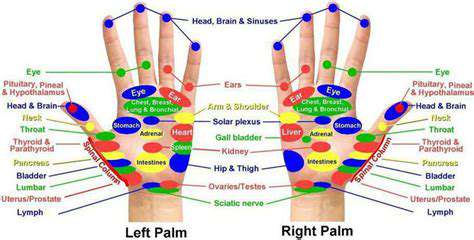Techniques for Effective Self-Acupressure

Understanding the Fundamentals of Self-Acupressure
Self-acupressure, a practice rooted in traditional Chinese medicine, involves applying pressure to specific points on the body to alleviate pain, promote relaxation, and potentially influence various bodily functions. Understanding the basic principles of acupressure is crucial for effective self-treatment. This involves recognizing the meridians, pathways of energy that connect different parts of the body. These meridians are thought to influence the flow of qi, a vital energy that maintains balance and harmony within the body. Identifying these points, often depicted on diagrams, is an important first step.
Learning about the various types of pressure and techniques is also key. Gentle, sustained pressure is often recommended for relaxation and pain relief. However, different points may require different levels of pressure, depending on the specific ailment. Understanding these nuances allows for a more tailored approach to self-treatment. The intention behind the application of pressure is critical; a focused and intentional approach can enhance the effectiveness of the practice. Proper technique and awareness of the body's response are essential for a safe and positive experience.
Identifying Key Acupressure Points
Locating the specific acupressure points on your body is paramount. These points, often referred to as acupoints, are believed to be energetically active areas that, when stimulated, can influence the body's response to various ailments. There are numerous acupressure points throughout the body, each associated with different organs and functions. Understanding the relationships between these points and their corresponding meridians can help you target specific needs.
Different acupressure points serve various purposes. Some points are known for their ability to reduce stress and promote relaxation, while others are associated with pain relief. Researching the specific points related to your concerns, and understanding the targeted effects of each one, can help you utilize self-acupressure more effectively. Consistent practice and familiarity with the location of these points are crucial for achieving desired outcomes.
Applying Pressure and Techniques for Optimal Results
Once you've identified the desired acupressure points, applying appropriate pressure is essential. The pressure should be firm, but not painful, and should be maintained for a specific duration. This can vary depending on the point and your individual needs. Applying pressure for several minutes can enhance the effectiveness of the treatment.
Various techniques can be employed to optimize the results. For example, you can use your fingers, thumbs, or even specialized tools to apply pressure. The key is to find the pressure and technique that works best for you, and to maintain consistent application. Consistency in pressure and technique will help you to better understand your own body's responses and adjust your approach accordingly.
Maintaining a Consistent Practice and Addressing Concerns
Regular practice is key to experiencing the benefits of self-acupressure. Consistent application of pressure to the targeted points can help to balance the body's energy and promote overall well-being. This practice can become a valuable tool in managing everyday stress and promoting relaxation.
It's important to be aware of any potential side effects or concerns. If you experience any discomfort or pain while practicing self-acupressure, stop immediately and consult with a healthcare professional. Always consult a healthcare practitioner before using self-acupressure for chronic conditions or if you have any underlying health concerns. This practice should be used in conjunction with, not in place of, professional medical advice.
Integrating Self-Acupressure into Your Daily Routine

Benefits of Self-Acupressure
Self-acupressure, a technique that involves applying pressure to specific points on the body, offers a multitude of potential benefits for overall well-being. It can be a powerful tool for managing pain and discomfort, promoting relaxation, and potentially even boosting the immune system. By stimulating these points, the body's natural healing mechanisms can be triggered, leading to a more balanced and harmonious state. This practice is often seen as a complementary approach to traditional medical care, potentially aiding in pain relief and stress reduction.
Many individuals find self-acupressure techniques to be a readily accessible and affordable way to improve their health and well-being. The simplicity of the practice, coupled with its potential therapeutic advantages, has made it a popular alternative method for managing various ailments. For those seeking natural pain relief, self-acupressure may offer a viable and non-invasive option. Learning the techniques and applying them consistently can lead to significant improvements in overall comfort and vitality.
Techniques and Applications
Mastering self-acupressure involves understanding the specific pressure points and the appropriate techniques for applying pressure. Practitioners typically use their fingers, thumbs, or even specialized tools to apply varying degrees of pressure to these points. Learning the precise locations and the appropriate pressure level is crucial for achieving the desired effect. There are various resources available, including books, websites, and even courses, to guide individuals through the process.
Self-acupressure can be applied to a range of issues, from headaches and muscle tension to digestive discomfort and even emotional distress. The technique is often used for relieving tension headaches by applying pressure to points around the temples and forehead. It can also help alleviate menstrual cramps and other common pain conditions. Understanding the specific applications for different issues can lead to a more targeted and effective approach.
Understanding the different types of pressure and the duration of application is essential for optimal results. Applying gentle, sustained pressure is often recommended for relaxation and pain relief. Applying more intense pressure might be necessary for certain conditions. By understanding the nuances of the technique, individuals can tailor their approach to their unique needs and circumstances.
Safety and Considerations
While generally considered safe, self-acupressure should be approached with caution and awareness. It's essential to consult with a healthcare professional before incorporating this practice, especially if you have any underlying health conditions. Some individuals might experience mild discomfort or sensations during the process, but persistent pain or unusual reactions warrant immediate consultation with a doctor.
It's crucial to learn the correct techniques from reputable sources. Improper application can potentially lead to unintended consequences or exacerbate existing issues. Seeking guidance from a qualified practitioner or researching reliable resources can help ensure safe and effective practice. Understanding the limitations of self-acupressure and when to seek medical attention is vital for a positive experience.
Important Considerations and Precautions

Understanding Potential Risks
Properly assessing the potential risks associated with any undertaking is crucial for minimizing negative consequences. This involves identifying all foreseeable hazards and evaluating their likelihood and severity. A comprehensive risk assessment allows for proactive mitigation strategies to be implemented, thereby significantly reducing the probability of adverse outcomes. Thorough risk analysis is a cornerstone of successful project management. Failing to adequately consider potential risks can lead to unforeseen problems and setbacks.
Understanding the potential consequences of each risk is just as important as identifying the risks themselves. This involves considering the impact on various stakeholders, including employees, customers, and the environment. A comprehensive understanding of these potential consequences enables the development of appropriate risk mitigation strategies.
Implementing Protective Measures
Once potential risks are identified and assessed, it's essential to implement appropriate protective measures. These measures can range from simple preventative actions to more complex safety protocols. Implementing these measures effectively is a critical step in safeguarding resources, assets, and personnel. Consistent adherence to these protective measures is paramount for maintaining a safe and productive environment.
Robust safety protocols, including regular training and drills, are often necessary to ensure that personnel are equipped to handle potential emergencies. Implementing these protocols can significantly reduce the likelihood of accidents and injuries.
Maintaining Compliance with Regulations
Staying compliant with relevant regulations and standards is absolutely vital. This involves adhering to all applicable laws and industry standards, which can vary depending on the specific context. Failure to comply with regulations can result in significant penalties and reputational damage. Regularly reviewing and updating compliance procedures is crucial for staying ahead of evolving regulations.
Maintaining accurate records of compliance activities is also essential for demonstrating adherence to standards. This helps in audits and inspections, and provides a crucial safeguard against non-compliance issues.
Prioritizing Employee Safety
A critical aspect of any project or undertaking is prioritizing employee safety. This includes providing necessary safety equipment, training, and a safe work environment. Protecting employee well-being and safety should be a top priority. It's not only ethical but also crucial for maintaining productivity and minimizing workplace accidents.
Regular safety checks and inspections are essential to ensure that the work environment remains compliant with safety standards. Open communication channels regarding safety concerns are also vital for fostering a culture of safety and well-being among employees.
Effective Communication and Reporting
Clear and effective communication channels are essential for disseminating important information regarding risks and protective measures. This includes regular updates, alerts, and procedures for reporting incidents or concerns. Transparent communication fosters a proactive approach to risk management. This allows for swift responses to potential issues and helps maintain a secure environment for all involved.
Establishing a robust reporting mechanism is also vital. This ensures that any incidents, near misses, or safety concerns are documented and addressed promptly. Implementing a reporting system that encourages open communication is a critical factor in improving overall safety practices.